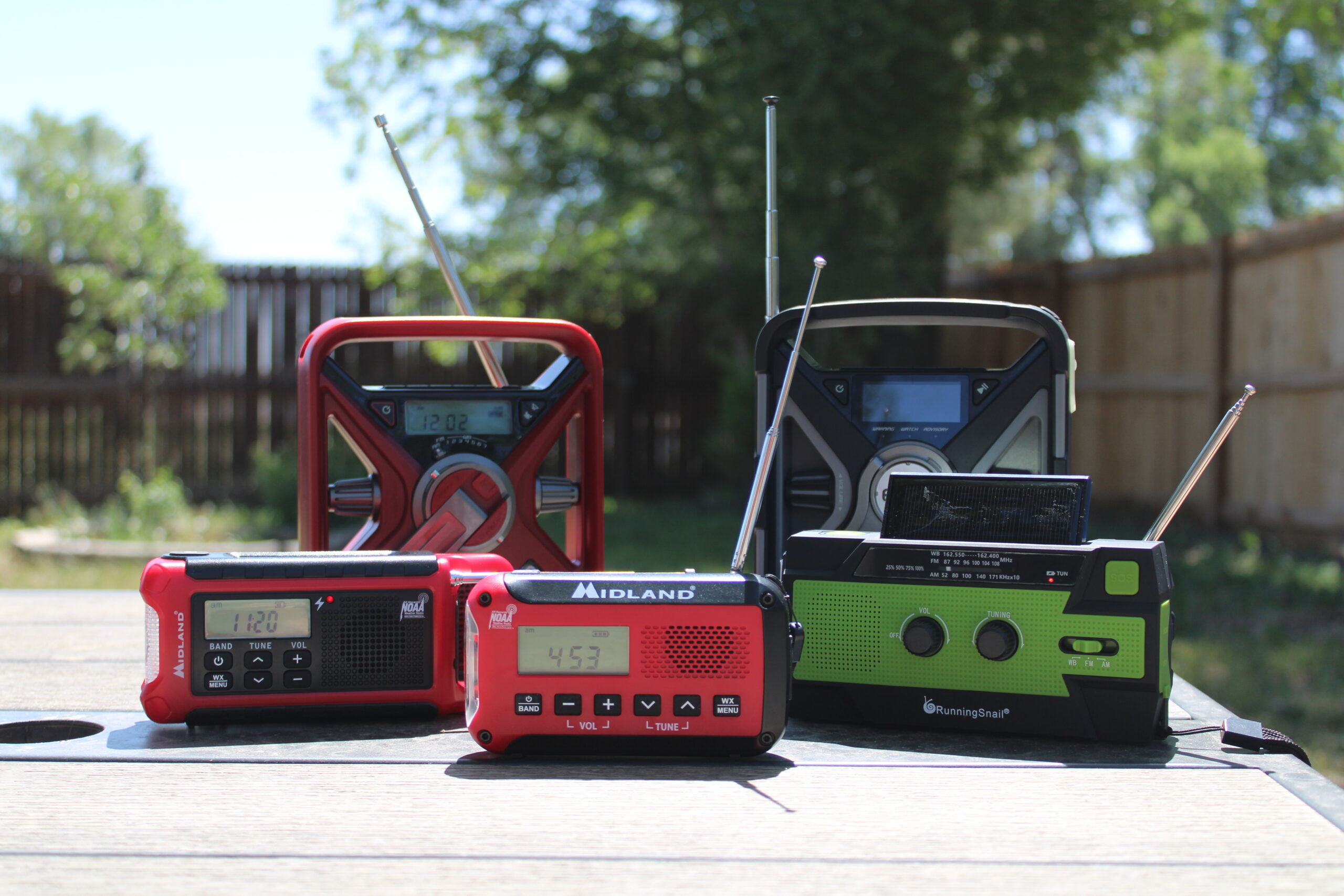We may earn revenue from the products available on this page and participate in affiliate programs. Learn More ›
In this digital age, where we rely on our phones for so much information, it’s easy to overlook the good old radio. But an emergency radio will keep you informed with news and weather when the power is out or you’re off grid. They also have helpful features like chargers and flashlights built into them. While there is a list of viable products on the market, I helped you narrow down that list by testing five of the best emergency radios available.
How We Picked The Best Emergency Radios
Each emergency radio has different capabilities and standards, so there were some variances with each device. To get a feel for a radio’s most basic feature, I tested the radios in town as well as in the mountains to see how strong of a signal I could receive. Impressively, I didn’t find a whole lot of difference between the areas where I easily had cell phone service and the areas with rolling hills where a radio would be necessary.
Here’s a breakdown of the other items I tested.
- Solar panels – The Etons, Midland Emergency Radio and the RunningSnail radio all come with a solar panel. They’re all more or less the same size, but each radio has different features and size batteries so I imagine this isn’t an exact science. I simply left them outside to see how quick they could charge and evaluated who’s battery charge went up the most.
- Hand Cranks – A hand crank is fairly standard on most emergency radios, and similar to the solar panels, I simply compared how well the hand crank-powered each device.
- Bluetooth – This is probably a newer feature for a lot of these classic radio companies. Only one device has this, so I simply connected it.
The Best Emergency Radios: Reviews & Recommendations
Best Overall: Midland ER210 Weather Alert Crank Radio
Midland ER210 Weather Alert Crank Radio
See It
Key Features
- AM/FM/Weather band Radio
- Additional weather alerts
- USB charger
- Headphone jack
- Solar panel charging
- Crank army charger
- Flashlight
- Dimensions: 7.5 x 5.25 x 2 inches
Pros
- NOAA certified
- Simple design and easy to use
- USB charger can charge phones and other devices
- Strong solar panel charging capabilities
Cons
- Solely focused on operating as an emergency radio
When it comes to emergency radios, Midland is a household name, and this radio is one of their most popular. Plus, it’s certified by the National Oceanic Atmospheric Administration, better known as NOAA.
The Midland ER 210 is what probably comes to mind when you think of emergency radios. The simple device does exactly what it’s meant to do, keep you informed and safe during severe weather like flooding, wildfires, and hurricanes. Right out of the box, it is very easy to navigate the different channels and find a radio source no matter where I used it. There’s a solar panel on the radio, and during testing I found that it charged impressively fast for such a small solar panel. Especially considering I only had it outside a short amount of time. While it’s not a true con, as the product does exactly what it is, the simplicity may have some shoppers looking at other options that include additional accessories. I will say the most surprising feature of the ER 210 was the USB in and out. The modern amenity means you can charge the radio with a USB while also using the radio to charge other items like a smartphone.
Best Value: FosPower
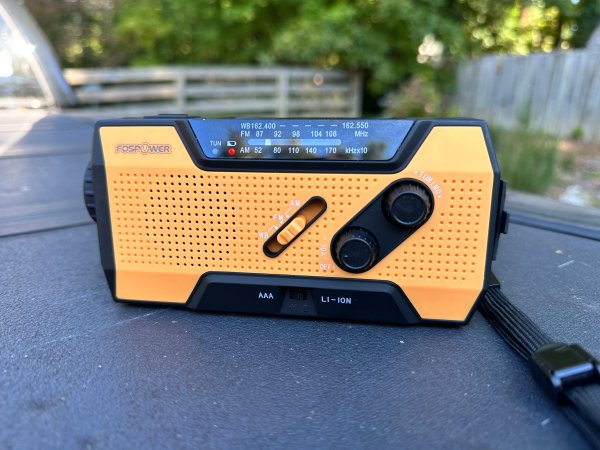
Photo by Scott Einsmann
See It
Key Features
- Radio: FM, AM, WB (162.400 to 162.550)
- Can charge a phone or other electronics via USB ports
- Powered by AAA, internal lithium battery, solar, or hand crank
- Two flashlights (low and high output)
- SOS alarm (makes a loud siren noise)
- Price: $40
Pros
- The various power sources work as advertised
- Easy to use
- Clear radio signal
- Multi function design makes this an asset in any emergency
Cons
- A larger solar panel would be preferable for quickly charging the battery
An emergency radio has one basic job: provide you with emergency broadcasts in any circumstance. The FosPower does that with it’s wide-band radio, which is how emergency services transmit messages. If the AAA batteries you put in it are dead, don’t worry. It has an internal lithium battery that can be charged with the hand crank or solar panel. I took my FosPower from dead to enough power to charge my phone, turn on the flashlight, and listen to the radio in just a few minutes of cranking. I don’t recommend being so cavalier with your battery in an emergency scenario, but it’s nice to know that if you had to use all those functions at once, you can do it.
Once I got the battery charged up, I flipped the radio to the WB setting and used the tuner knob to find my area’s broadcast. I heard a clear, crisp weather report. I fiddled with the FM setting and listened to music and news as well. The flashlights on the FosPower aren’t very powerful, but they are bright enough to find your way indoors or even signal for help. Speaking of signaling, there is an SOS alarm which creates a loud siren noise. That could be useful to alert someone of your location in an emergency.
This isn’t a device that will allow you to listen to broadcasts for hours, or use as a primary flashlight in an emergency. To me, it’s an emergency radio you can use to get the latest report and then shut it off to save the battery. Some of the larger radios in this buying guide can be used to listen to the radio for hours or even days.
Best for Preppers: Eton Sidekick
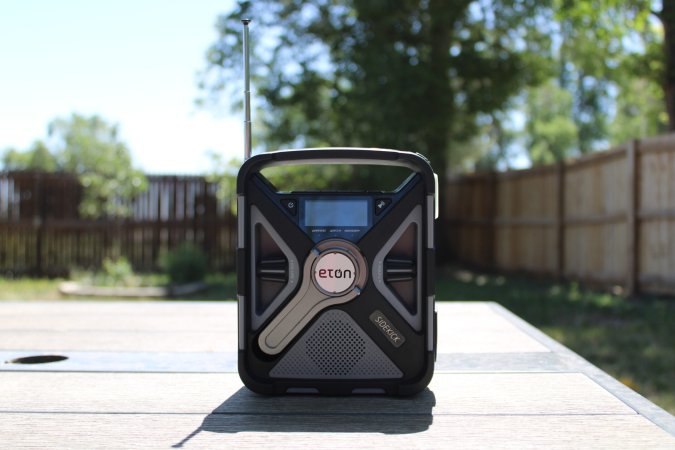
Eton Sidekick
See It
Key Features
- AM/FM/Weather band radio
- Bluetooth connection
- Flashlight
- Larger ambient light
- USB charging and to charge smartphones
- Solar charging
- Crank charging
- Headphone jack
- Durable design
- Dimensions: 2.9 x 7.8 x 12.7 inches
Pros
- An endless list of capabilities even compared to the next best competitor.
- Super durable design and a handle at the top allow the Sidekick to be easily carried.
- The does-it-all concept makes this a great device for emergencies or camping trips.
Cons
- One of the more expensive products on the market
- The solar panel doesn’t charge that well
The Eton Sidekick is an emergency radio, but in a lot of ways, it’s more than that. With the added Bluetooth and phone charging capabilities, this is a great device to also take camping, or in some cases, one of the best emergency radios for preppers. Having the laundry list of capabilities makes this a great device in any situation.
The added Bluetooth was my favorite advantage of the product, as you can stream music or other audio from your phone. That was followed by a close second of the ambient light that makes up the entire backside of the radio. This is a great light to have at night in a tent or sitting around a campfire without being too bright. All the radio capabilities and Bluetooth also worked at home and in the mountains, meaning you can take it anywhere. Plus, the battery lasts a very long time. It also has one of the easier cranks to use as the product’s face is flat, and it’s easy to turn.
However, the small solar panel grid at the top of the product was lacking compared to the best solar panels for camping. It didn’t do much to add a charge but would work for someone using this solely for emergency reports in a dire situation.
Read Next: Best Survival Food
Best Rated: Eton FRX3+
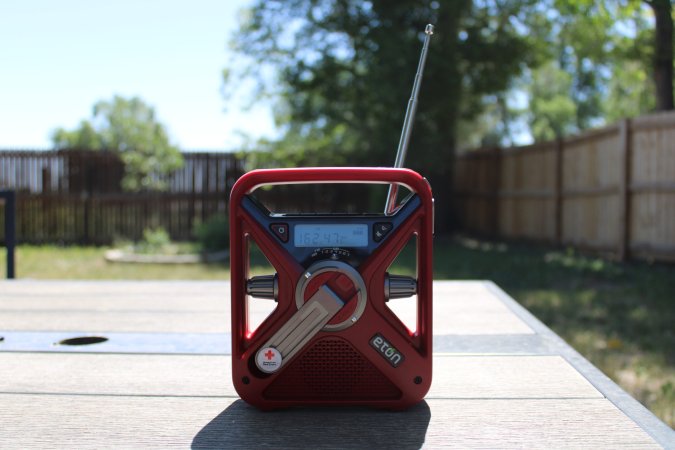
Eton FRX3+
See It
Key Features
- AM/FM/Weather band radio
- USB smartphone charging
- Solar panel charging
- LED flashlight
- Glows in the dark
- Headphone jack
- Dimensions: 6.9 x 5.8 x 2.6 inches
Pros
- Red Cross endorsement creates an added piece of mind
- The crank arm works great
- Additional buttons for volume and tuning
Cons
- Pricier compared to the Midland radio, which is its main competition
- Eton sells the Sidekick for just a few dollars more for a product with added durability and abilities
- The solar panel is underwhelming
The FRX3+ is similar to the Sidekick in many ways but without the added durable feel. As far as capabilities go, it’s on par with the Midland ER 210. Out of the box, it feels noticeably less durable than other products. This is Eton’s design for a product that is solely for emergencies. That said, the product did everything it said it would. With the same-looking solar panel as the Sidekick, the FRX3+ also didn’t generate a charge very quickly, but unlike the Sidekick, the charge was enough for the intended job of this being just a radio to alert you during severe weather. The price tag is fairly high on this one, but the American Red Cross stamp shows the extra cash may be worth it.
Best Budget: Midland Emergency Alert Radio ER10VP
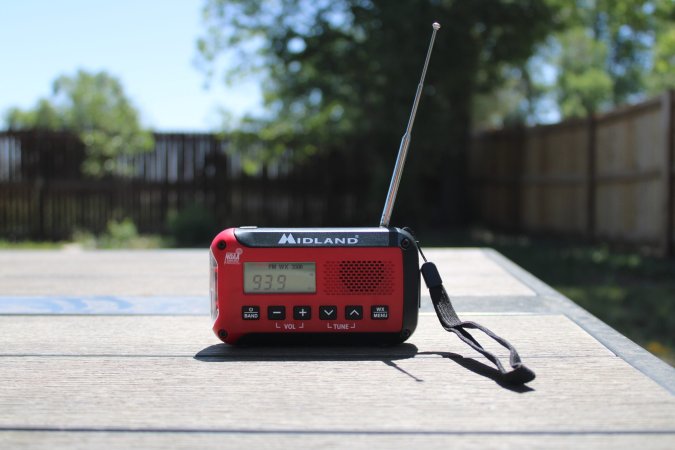
Midland Emergency Alert Radio ER10VP
See It
Key Features
- AM/FM/Weather band radio
- Flashlight
- Headphone jack
- Dimensions: 5.98 x 5.28 x 1.46 inches
Pros
- Very cost-effective
- Can still be used in emergencies
Cons
- No added accessories or ways to charge it besides fresh batteries
With a NOAA certification but at half the price and even simpler than the other Midland radio, the Midland ER10VP is an item that should be found in every home. Out of the package, the radio is the size of two decks of cards stacked and is very easy to use. It can easily fit in a kitchen drawer or somewhere else for easy access if bad weather were to move in. This could also be carried by weight-conscious backpackers and other campers who simply want to get a weather report and have a flashlight, in addition to their primary best flashlight.
Unlike some of the other radios, this one still uses standard batteries, which I see as being a plus or minus depending on who you ask. There’s also no other way to charge it if the batteries die, and I would recommend keeping three extra AAA batteries in the event of an emergency.
Best Portable: RunningSnail Emergency Crank Radio
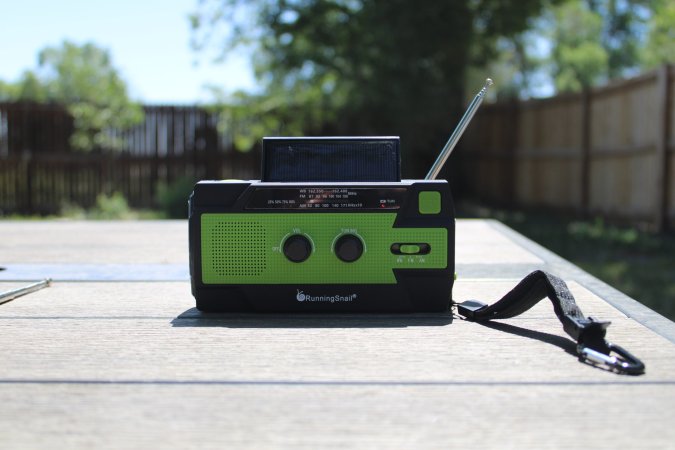
RunningSnail Emergency Crank Radio
See It
Key Features
- AM/FM/Weather band radio
- Solar panel charging
- Crank charging
- USB charger for smartphones
- SOS Alarm
- Two different lights
Pros
- More affordable than similar emergency radios
- SOS system with flashing lights and an audible alarm
- Power solar panel system for charging
Cons
- Weighs a little more than similar-sized radios
- Feels cheaper than Midland products
The RunningSnail Emergency Crank Radio out of the box looks a little bit more like a toy compared to other products but works just as well. I left it outside before charging it otherwise, and it was quickly charged with the help of the sun. This radio has one of the most impressive solar panel charging abilities as it charged quickly and lasted a very long time. Many of the radios also have an SOS system that flashes the flashlight, but on the RunningSnail, it flashes red and sounds an alarm. The sound was enough to scare my dog and seems like a great addition to any device that could be used to save your life. These added benefits and low price makes this a great portable radio to bring with you on trail or overlanding.
Best Two Way: Rocky Talkie Mountain Radio

See It
Key Features
- Range: 25+ miles
- Over three days of battery life, even in very cold conditions (-20F)
- Weight: 4.8 ounces (radio only) 7.9 ounces (full system)
- 128 channels and 121 privacy codes
- IP56 water resistance
- Shatterproof LED screen
- Thermoplastic protective covering
- Ultralight carabiner and backup leash
- Two-year warranty
Pros
- Rugged
- Lightweight
- Ultralight carabiner
Cons
- Splashproof and snowproof, but not submergible
- Does not support NOAA weather channels
The Rocky Talkie is the best overall walkie talkie because it is rugged, lightweight, and reliable. Even with thick gloves on, the push-to-talk button is easy to depress and it is difficult to accidentally turn off as the power button is small and protected by raised plastic. The fact that it is rechargeable is also fantastic because you can top off the power for trips longer than three days. There’s a leash and ultralight carabiner to prevent drops, but even if it does fall, consequences are low as long as it doesn’t bounce off a cliff. There is no battery back panel to explode in all directions and they’re designed to be shatterproof and weatherproof. To save on weight, Rocky Talkies do not have access to NOAA weather alerts or channels so come prepared or have another method to receive weather updates.
Let’s talk about the advertised range on 2 way radios. If you’re in an empty, sprawling field and your friend is standing 25 miles away, you’ll likely be able to talk to them. The advertised range means a line of sight with no interference. However, trees, mountains, hills, and buildings can interrupt your transmission. Therefore, Rocky Talkie says their max range is over 25 miles, but 1 to 5 miles is more typical in backcountry terrain. When skiing, mountain biking, trail running, or otherwise recreating in a mountainous region, you’ll typically be able to communicate when your party is on the same side of the mountain and lose service if you’re separated by the peak.
I use these regularly for skiing and hiking. They perform well relaying crisp messages and peace of mind. It is not uncommon here in Salt Lake City to meet up with a group for an activity and everyone turns a few out of their pockets. They are a popular piece of gear that keeps groups together in many regions and climates. Pro tip: Put a colorful piece of tape on yours so they make their way back to you post-ride. —Ashley Thess
Read our full review of the Best Two-Way Radios for more information.
Best Ham Radio: Baofeng UV-5R
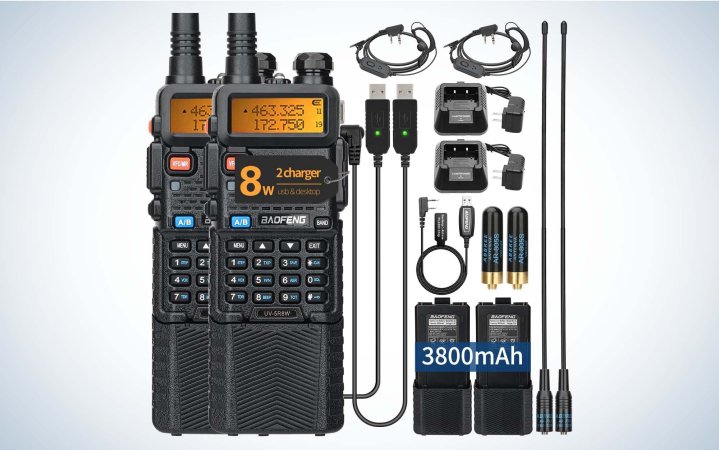
See It
Key Features
- Dual band
- 128 Channels 50 CTCSS and 104 CDCSS Dual-Band Display
- 3800mAh Battery and USB Charge
- USB programming cable
- Busy channel lock-out
- Emergency Alert: 25KHz/12.5KHz switchable
- LED Flashlight: Hight /Low RF Power switchable
Pros
- Affordable
- Many accessories available
Cons
- Not the ultimate radio for enthusiasts
If you don’t want to get an amateur radio license to legally operate a ham radio, but want one around for emergencies, the UV-5R is a great, affordable option. A ham radio will allow you to listen to emergency broadcasts and local chatter to stay informed on the emergency. There are no rules against someone owning a ham radio and using it to monitor, you just can’t broadcast without a license. There are special provisions for broadcasting during a declared state of emergency and during times when other communications systems are down.
Things to Consider When Looking for the Best Emergency Radios
Weather radios provide communication from the outside world and multiple other options like flashlights, phone chargers, and more to keep users prepared for almost any situation. The top emergency radios are a growing spectrum of prices and accessories, so here’s how to find the best weather radio for you.
Price
The majority of emergency radios are affordable to most users. Still, it’s fair to say there are some poor-quality models on the market, so reading reviews and trusting a brand with certification from an organization like NOAA or the American Red Cross adds additional reassurance to the product.
Ease of Use
Most of the radios are easy to set up for the average user. Still, people with questions can find a long list of local meteorologists and others who have created YouTube videos to answer any additional questions you may have.
Features
From a basic outlook, most emergency radios come with FM, AM, and weather band radio, allowing users to get updates from the media and emergency broadcasts in certain situations. Additional features to help people prepare for power outages include hand cranks, solar panels, flashlights, and SOS signaling that could be vital in disastrous situations. While the chargers on emergency radios are fantastic, they aren’t a replacement for one of the best power banks for camping. For anyone looking to get additional accessories or to use their radio for outings like a camping trip, multiple radios have features like Bluetooth and charging capabilities to make it a great device for the backcountry as well. Some of these capabilities may be worth spending a few more dollars to have a more well-rounded product.
FAQs
Federal agencies like NOAA recommend having an emergency radio in your home. These simple devices can make a big difference, especially now when there’s an overreliance on smartphones and the internet. If you were to lose power or a cell tower went down, you would be left with nothing. Having this as an inexpensive backup item could make a difference.
Secondly, they work in areas where your phone may not have a signal and could warn travelers about current and upcoming weather conditions.
This is dependent on the person. For the most part, however, some basic accessories can only upgrade your product in an emergency. Simple additions like a hand crank allow you to power your radio when batteries have died. Other more elaborate accessories like Bluetooth may just make the item more appealing to the user.
It’s fair to say most cost between $20 to $100. The price variation is broken down by how many added capabilities each radio has. From solar panels to USB charging and added lights, each radio is different. It’s up to you to decide your budget and to figure out how many accessories you want for your radio.
Final Thoughts on the Best Emergency Radios
You might never need to use one of the best emergency radios. But, if you do need it one day, you’ll be glad you have it. While prices and capabilities vary, plenty of today’s radios have added features like Bluetooth and lighting that can make them useful while camping or at home. Plus, these radios bring the benefit of peace of mind that you’re prepared for an emergency—and that’s priceless.
Read the full article here
